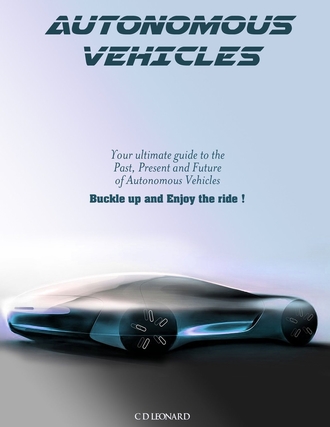
Autonomous Vehicles by C D Leonard is a well-considered, wide-ranging examination of self-driven vehicles and their implications for the economy, ethics, and everyday life.
This comprehensive guide begins by posing two questions: What is autonomous driving, and how does it differ from normal driving as we currently know it? Indications are that the development of the autonomous car will require further new technologies to improve, protect and finally eliminate the driver. There are six possible levels of autonomous driving, ranging from complete human control, through partial, conditional, high and finally full control by the vehicle. Vehicular control would require the current manufacturing process in tandem with increasingly advanced software.
Some driver supports are already in place, such as cruise control, a rather old development from the 1950s-60s. Other like GPS are recent but already widespread use. Others like LIDAR (Light Detection and Ranging) are in the experimental stages; with LIDAR, the vehicle can “see” better than the human eye, avoid stationary obstacles and even track other moving objects. With such technologies the autonomous vehicle would make decisions and choices that were once made by a human driver. There are many legal implications: who is responsible if an autonomous vehicle has a crash? New insurance legislation would be needed, and political factors would come into play.
Author Leonard has organized his information with laudable skill, using colorful graphics, charts and other devices, as well as a logical arrangement of the overall subject matter. His book incorporates various algorithms and scientific data while maintaining a sense of drama and purpose that any average reader can appreciate. His points on this important issue are thought provoking. His own conclusion is that the autonomous vehicle is on the way and will provide more positives than negatives for all of us. While that point is of course debatable, Leonard’s thinking is derived from the banks of data already available. For example, the use of drive sharing – a stepping stone to driverless transportation – is already on the rise.
Leonard carefully covers the negatives of autonomous vehicle development – such as loss of employment, mainly employment of truck drivers – with the potential addition of other kinds of jobs like vehicle maintenance and remote road monitoring that may perhaps compensate. He balances these issues with positive statistics, such as that 1.2 million people are killed in road accidents globally (about 33,000 in the US) each year. He then sagely asserts the prediction that autonomous vehicles would reduce that figure by as much as half by 2045, while also eliminating time-consuming traffic jams and increasing convenience. AVs use less fuel and stay on the road 24 hours a day, so moving goods will be faster and more efficient.
In all, it provides a persuasive argument. Though it make take some time for the technology to be widespread, Leonard makes a good case for why the technology should be pursued to its fullest. It’s a well-timed book, given the amount of press the subject has received recently, and you will think differently about the advantages and disadvantages of driverless cars by book’s end.
If anything, the book veers a little too close to cheerleading its topic, but as the industry is really at the “horseless carriage” stage of adoption, these are arguments that need to be discussed. As such, Autonomous Vehicles is recommended if you have cursory knowledge of the subject, or if you know the industry well, as it is full of fascinating ideas and implications for the future.
Book Links
STAR RATING
Design
Content
Editing
Get an Editorial Review | Get Amazon Sales & Reviews | Get Edited | Publish Your Book | Enter the SPR Book Awards | Other Marketing Services























Leave A Comment